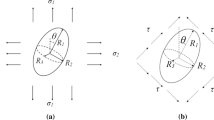Abstract
The fracture of mild steel in the cleavage range has been evaluated using a weakest link statistical model, assuming the preexistence of a distribution of cracked carbides. The model provides a rationale for the critical fracture distance, viz., the distance from the crack tip at which the probability of cleavage cracking exhibits a maximum. The critical distance depends on the size distribution and volume fraction of carbides. The model also predicts trends in K,ic with material properties: flow strength, cracked carbide size and volume fraction, and grain size. The resultant temperature dependence of K,ic is shown to derive exclusively from the temperature dependence of the flow stress, as in prior models. The effects of microstructure on K,ic depend primarily on the size distribution of cracked carbides, with additional influences of the grain size and of the volume fraction of carbides.
Similar content being viewed by others
References
R. O. Ritchie, J. F. Knott, and J. R. Rice:J. Mech. Phys. Sol., 1973, vol. 21, p. 395.
D.A. Curry and J.F. Knott:Metal Science, 1978, vol. 12, p. 511.
D. M. Parks:Jnl. Eng. Mtls. Technology, Trans. ASME, Ser. H, 1976, vol. 98, p. 30.
S. P. Rawal and J. Gurland:Metall. Trans. A, 1977, vol. 8A, p. 691.
D.A. Curry and J.F. Knott:Metal Science, 1976, vol. 10, p. 1.
R. O. Ritchie, W. L. Server, and R. A. Wullaert:Metall. Trans. A, 1979, vol. 10A, p. 1557.
D.A. Curry and J.F. Knott:Metal Science, 1979, vol. 13, p. 341.
D. A. Curry:Metal Science, 1980, vol. 14, p. 319.
A. Pineau:Advances in Fracture Research, D. Francois, ed.,Pergamon, New York, NY, 1981, vol. 2, p.553.
E. Smith:Physical Basis of Yield and Fracture, Inst. Phys./Phys. Sci.,Oxford, 1966, p. 36.
J. D. G. Groom and J. F. Knott:Metal Science, 1975, vol. 9, p. 390.
M. Holtzman and J. Man:Jnl. Iron and Steel Institute, October 1971, p. 836.
J. R. Matthews, W. Shack, and F. A. McClintock:Jnl. Amer. Ceram. Soc, 1976, vol. 59, p. 304.
A. G. Evans and R. L. Jones:Jnl. Amer. Ceram. Soc, 1978, vol. 61, p. 156.
J.W. Hutchinson:J. Mech. Phys. Solids, 1968, vol. 16, p. 1.
J. R. Rice and G. F. Rosengren:J. Mech. Phys. Solids, 1968, vol. 16, p. 1.
J. W. Hutchinson:Acta Met., in press.
G.T. Hahn, R.B. Hoagland, and A. R. Rosenfield:Metall. Trans., 1971, vol. 2, p. 537.
A.R. Rosenfield and D. K. Shetty: Battelle Research Labs, Columbus, OH, unpublished research, 1983.
R. O. Ritchie: Ph.D. Thesis, Cambridge Univ., 1972.
J. R. Rice and E. P. Sorensen:Jnl. Mech. Phys. Solids, 1978, vol. 26, p. 163.
Author information
Authors and Affiliations
Rights and permissions
About this article
Cite this article
Evans, A.G. Statistical aspects of cleavage fracture in steel. Metall Trans A 14, 1349–1355 (1983). https://doi.org/10.1007/BF02664818
Received:
Issue Date:
DOI: https://doi.org/10.1007/BF02664818



